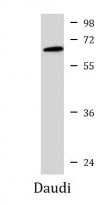ARG55022
anti-YY1 antibody
anti-YY1 antibody for Western blot and Human
Controls and Markers antibody; Gene Regulation antibody; Neuroscience antibody
Overview
| Product Description | Mouse Monoclonal antibody recognizes YY1 |
|---|---|
| Tested Reactivity | Hu |
| Tested Application | WB |
| Host | Mouse |
| Clonality | Monoclonal |
| Clone | 1183CT6.5.23.6 |
| Isotype | IgG2a |
| Target Name | YY1 |
| Immunogen | Purified His-tagged YY1 protein. |
| Conjugation | Un-conjugated |
| Alternate Names | YY-1; UCRBP; INO80S; NF-E1; Delta transcription factor; Yin and yang 1; DELTA; YIN-YANG-1; Transcriptional repressor protein YY1; INO80 complex subunit S |
Application Instructions
| Application Suggestion |
|
||||
|---|---|---|---|---|---|
| Application Note | * The dilutions indicate recommended starting dilutions and the optimal dilutions or concentrations should be determined by the scientist. | ||||
| Positive Control | Daudi |
Properties
| Form | Liquid |
|---|---|
| Purification | Purification with Protein G. |
| Buffer | PBS and 0.09% (W/V) Sodium azide |
| Preservative | 0.09% (W/V) Sodium azide |
| Storage Instruction | For continuous use, store undiluted antibody at 2-8°C for up to a week. For long-term storage, aliquot and store at -20°C or below. Storage in frost free freezers is not recommended. Avoid repeated freeze/thaw cycles. Suggest spin the vial prior to opening. The antibody solution should be gently mixed before use. |
| Note | For laboratory research only, not for drug, diagnostic or other use. |
Bioinformation
| Database Links |
Swiss-port # P25490 Human Transcriptional repressor protein YY1 |
|---|---|
| Gene Symbol | YY1 |
| Gene Full Name | YY1 transcription factor |
| Background | YY1 is a ubiquitously distributed transcription factor belonging to the GLI-Kruppel class of zinc finger proteins. The protein is involved in repressing and activating a diverse number of promoters. YY1 may direct histone deacetylases and histone acetyltransferases to a promoter in order to activate or repress the promoter, thus implicating histone modification in the function of YY1. [provided by RefSeq, Jul 2008] |
| Function | Multifunctional transcription factor that exhibits positive and negative control on a large number of cellular and viral genes by binding to sites overlapping the transcription start site. Binds to the consensus sequence 5'-CCGCCATNTT-3'; some genes have been shown to contain a longer binding motif allowing enhanced binding; the initial CG dinucleotide can be methylated greatly reducing the binding affinity. The effect on transcription regulation is depending upon the context in which it binds and diverse mechanisms of action include direct activation or repression, indirect activation or repression via cofactor recruitment, or activation or repression by disruption of binding sites or conformational DNA changes. Its activity is regulated by transcription factors and cytoplasmic proteins that have been shown to abrogate or completely inhibit YY1-mediated activation or repression. For example, it acts as a repressor in absence of adenovirus E1A protein but as an activator in its presence. Acts synergistically with the SMAD1 and SMAD4 in bone morphogenetic protein (BMP)-mediated cardiac-specific gene expression (PubMed:15329343). Binds to SMAD binding elements (SBEs) (5'-GTCT/AGAC-3') within BMP response element (BMPRE) of cardiac activating regions. May play an important role in development and differentiation. Proposed to recruit the PRC2/EED-EZH2 complex to target genes that are transcriptional repressed. Involved in DNA repair. In vitro, binds to DNA recombination intermediate structures (Holliday junctions). Proposed core component of the chromatin remodeling INO80 complex which is involved in transcriptional regulation, DNA replication and probably DNA repair; proposed to target the INO80 complex to YY1-responsive elements. [UniProt] |
| Cellular Localization | Nucleus matrix Note=Associated with the nuclear matrix |
| Research Area | Controls and Markers antibody; Gene Regulation antibody; Neuroscience antibody |
| Calculated MW | 45 kDa |
| PTM | Transiently poly-ADP-ribosylated by PARP1 upon DNA damage, with the effect of decreasing affinity of YY1 to its cognate DNA binding sites. Ubiquitinated. |
Images (1) Click the Picture to Zoom In






